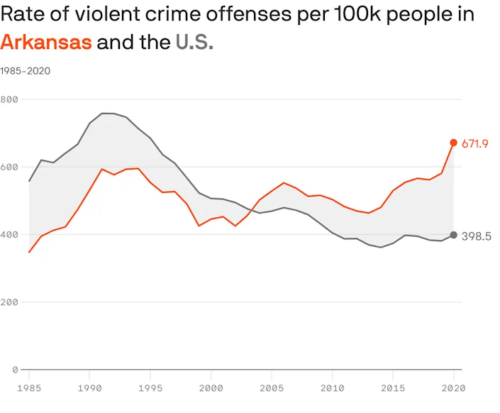
10.15.21 – Axios –
The rate of violent crime offenses – which include murder, rape, robbery and aggravated assault – rose by 15.6%.
Rate of violent crime offenses per 100k people in Arkansas and the U.S.
Last year, the estimated number of violent crimes in Arkansas spiked to its highest level in more than three decades. In fact, it exceeded the national rate for the 16th straight year, according to recent FBI statistics.
Behind the trend: Social and economic changes sparked by the pandemic likely contributed to the spike in violent crime nationwide, legal experts tell Axios’ Russell Contreras.
- Zoom in: Population growth in the state’s small cities — like Conway and Jacksonville — is likely a contributing factor to rising rates too, Grant Drawve of the University of Arkansas tells us.
By the numbers: Arkansas had a record number of violent crimes in 2020, a rate of 672 per 100,000 residents.
- The rate of violent crime offenses — which include murder, rape, robbery and aggravated assault — rose by 15.6%.
- The state’s homicide rate was up 36% from 7.8 per 100,000 Arkansans in 2019 to 10.6 in 2020.
Yes, but: Experts warn the data are flawed. That’s because the FBI relies on information reported by 18,000 law enforcement agencies to compile its Uniform Crime Report.
- There are gaps in how crimes are reported and prosecuted — even within the same state.
Context: Arkansas’ numbers are probably more accurate overall than much of the country’s because of the way the state reports them, Drawve says.
- Arkansas began transitioning to the National Incident-Based Reporting System (NIBRS) methodology in the early 2000s.
- NIBRS is more comprehensive than the historically used Uniform Crime Reporting method. It’s still partially used by most states.
- Only 20 states are exclusively using the NIBRS system.
What they’re saying: The change to NIBRS reporting in Arkansas over several years is likely why there’s a growing gap between the state and U.S. trend lines in the chart above, Drawve says.
What to watch: All states will begin transitioning to NIBRS reporting beginning this year. But changing methodology takes time and training.
- There will likely be some gaps and anomalies in crime data for the next couple of years.
